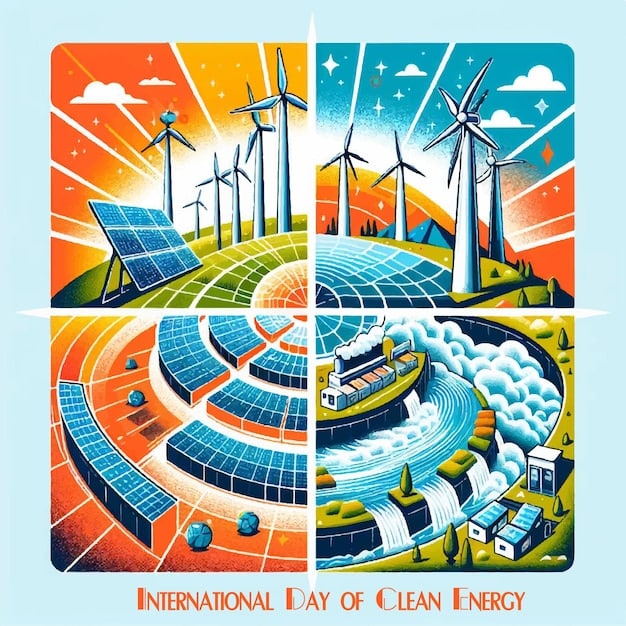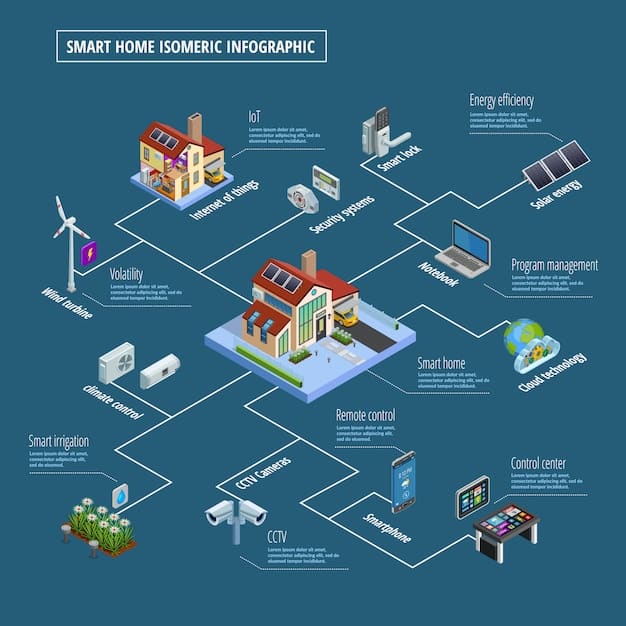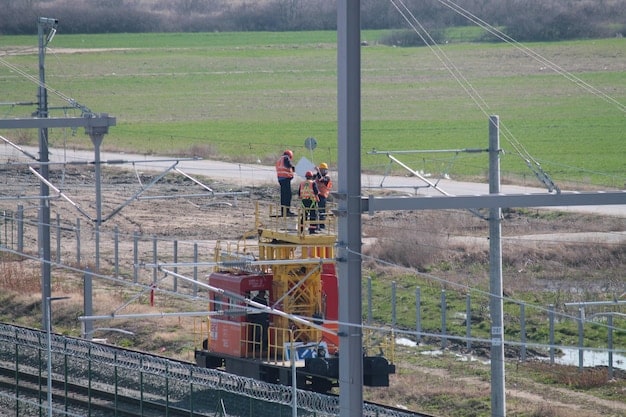US Renewable Energy: New Federal Funds Unlock Business Opportunities

Advertisements
New federal funding initiatives in the US renewable energy sector are creating significant opportunities for businesses in manufacturing, technology development, and project deployment, driving economic growth and innovation across the country.
Advertisements
The landscape of energy in the United States is undergoing a profound transformation, propelled by ambitious federal funding initiatives. These strategic investments are not merely shifting policy; they are actively reshaping the economic terrain, creating substantial new avenues for American businesses. Understanding what are the emerging opportunities for US businesses in the renewable energy sector, driven by the new federal funding initiatives, is crucial for entrepreneurs, investors, and established corporations looking to capitalize on this green revolution. This pivotal moment promises not only environmental benefits but also significant economic dividends for those prepared to innovate and adapt.
deciphering the federal funding landscape
Federal funding initiatives, such as the Inflation Reduction Act (IRA) and the Bipartisan Infrastructure Law (BIL), represent the most significant climate investments in US history. These legislative acts are designed to accelerate the transition to a clean energy economy through a comprehensive suite of tax credits, grants, and loan programs. Their scale and scope create a powerful market signal, driving private investment and innovation in previously underserved or nascent areas of the renewable sector.
Advertisements
The IRA, in particular, offers a long-term commitment, extending and expanding clean energy tax credits for a decade. This predictability is vital for businesses, enabling them to plan and invest with greater confidence. For instance, the Investment Tax Credit (ITC) and Production Tax Credit (PTC) are no longer tied to specific technologies but are now technology-neutral, rewarding clean electricity generation regardless of its source, provided it meets certain emissions standards. This broad approach encourages a wider array of innovative solutions.
Key Incentives for Businesses
These programs feature several components critical for business growth:
- Tax Credits: Direct financial benefits for renewable energy generation, manufacturing, and storage.
- Grants: Funding for research, development, and demonstration projects, particularly for cutting-edge technologies.
- Loan Programs: Government-backed loans and loan guarantees to de-risk large-scale clean energy projects.
Moreover, many of these incentives include “adders” for meeting domestic content requirements, utilizing energy communities, or serving low-income communities. Such provisions encourage localized production, job creation, and equitable distribution of economic benefits, making the funding initiatives a robust mechanism for driving broader economic development across the US. Understanding these nuances is essential for businesses to maximize their eligibility and tailor their strategies accordingly.
The sheer volume of capital flowing into the sector means an unprecedented demand for goods and services. From manufacturing solar panels and wind turbine components to developing advanced battery storage systems and implementing grid modernization projects, the opportunities are vast. This federal support is designed to build a resilient, clean energy infrastructure, fostering domestic supply chains and creating high-quality American jobs.
expanding opportunities in renewable generation and storage
The core of the renewable energy revolution lies in generating clean electricity and storing it efficiently for grid stability. Federal funding is significantly amplifying opportunities in both these areas, making them ripe for business expansion and innovation. For US businesses, this translates into a demand for highly sophisticated hardware, advanced installation services, and novel operational strategies.
Solar and wind energy, already mature technologies, are seeing unprecedented growth. The extended tax credits from the IRA mean developers have a clear financial incentive to deploy these systems at scale. This, in turn, boosts demand for everything from silicon wafers and photovoltaic cells to composite materials for turbine blades and specialized construction services for large-scale solar farms and wind parks. Businesses involved in the manufacturing, installation, and maintenance of these core components are poised for substantial expansion.
the rise of advanced storage solutions
Energy storage, particularly battery technology, is critical for integrating intermittent renewables into the grid. Federal initiatives provide significant support for:
- Battery Manufacturing: Incentives for domestic production of battery cells and components, reducing reliance on foreign supply chains.
- Grid-Scale Storage Projects: Tax credits that reduce the upfront cost of deploying large battery systems, enhancing grid resilience.
- Innovative Storage Technologies: Funding for R&D in alternative storage solutions like hydrogen, pumped hydro, and thermal storage.
This emphasis on storage not only creates direct manufacturing and deployment opportunities but also fuels the demand for specialized software for battery management systems and grid optimization tools. Companies with expertise in power electronics, materials science, and digital controls will find fertile ground for innovation. The push towards domestic manufacturing also supports the development of a skilled workforce and advanced technological capabilities within the US.
The integration of these generation and storage assets requires sophisticated grid infrastructure. This opens up avenues for businesses in smart grid technologies, including advanced sensors, digital controls, and cybersecurity solutions for energy systems. Companies that can offer comprehensive solutions for grid modernization, from hardware to software and consulting services, are in a prime position to thrive. The federal commitment to updating aging infrastructure reinforces these long-term growth prospects.
fostering innovation in emerging technologies
Beyond established renewable sources, federal funding is strategically targeting emerging technologies, aiming to accelerate their commercial viability and integrate them into the nation’s energy mix. This creates a high-stakes, high-reward environment for businesses focused on cutting-edge research, development, and demonstration projects. Investing in these less mature sectors is essential for achieving long-term decarbonization goals and maintaining the US’s competitive edge in the global green economy.
One of the most promising areas is green hydrogen production. Federal incentives, particularly production tax credits, are designed to make carbon-free hydrogen economically competitive with fossil fuel-derived hydrogen. This drives demand for electrolyzers, renewable electricity sources (critical for green hydrogen), and specialized infrastructure for hydrogen storage and transport. Businesses involved in chemical engineering, advanced manufacturing, and industrial gas production are well-positioned to pivot or expand into this nascent but rapidly growing market.
carbon capture, utilization, and storage (ccus)
While debated, CCUS technologies are receiving significant federal support, especially for hard-to-decarbonize industrial sectors. This opens doors for:
- Capture Technology Development: Innovation in chemical processes and materials for efficient carbon capture from industrial emissions.
- Geological Storage Solutions: Businesses specializing in geological surveying, drilling, and long-term monitoring of CO2 storage sites.
- Utilization Pathways: Research and commercialization of new products that use captured CO2 as a feedstock, like low-carbon fuels or building materials.
These initiatives encourage the development of a complex ecosystem of specialized companies, from engineering firms providing design and implementation services to monitoring and verification specialists ensuring long-term safety and effectiveness. The federal commitment frames CCUS as a critical component of a diversified decarbonization strategy.
Geothermal energy, often overlooked, is another area seeing renewed interest due to federal support. Advanced geothermal systems can provide constant, dispatchable power, overcoming the intermittency of solar and wind. Funding is supporting enhanced geothermal systems (EGS) research, which involves techniques to create or improve geothermal reservoirs. This creates opportunities for drilling companies, equipment manufacturers, and geological engineering firms to apply their expertise to a new frontier of clean energy.

supply chain resilience and domestic manufacturing
A critical pillar of the new federal funding strategy is the emphasis on strengthening domestic supply chains and boosting US manufacturing capabilities within the renewable energy sector. The goal is not just to deploy clean energy but to build a robust, self-sufficient industry that creates American jobs and reduces reliance on foreign components. This focus creates substantial opportunities for businesses across the manufacturing spectrum.
Incentives within acts like the IRA are explicitly designed to reward domestic content. For example, tax credits for solar and wind projects can be significantly increased if a certain percentage of components and manufactured goods are produced in the US. This creates a compelling economic case for companies to establish or expand manufacturing facilities stateside, ranging from polysilicon production for solar cells to steel fabrication for wind turbine towers.
Small and medium-sized enterprises (SMEs) have a crucial role to play in this domestic manufacturing push. While large corporations may assemble final products, SMEs often provide essential sub-components, specialized machinery, and processing services. This tiered demand creates a diverse range of opportunities across various industries, from precision machining and advanced materials to chemicals and electronics.
building a robust manufacturing ecosystem
The drive for domestic manufacturing has several ripple effects:
- Job Creation: Direct employment in factories, along with associated jobs in logistics, quality control, and supply chain management.
- Innovation in Production: Investment in advanced manufacturing techniques, automation, and sustainable production processes.
- Regional Economic Development: Revitalization of manufacturing hubs and creation of new industrial clusters in various states.
This push is also catalyzing investments in workforce development programs, ensuring a skilled labor pool is available to meet the demands of the expanding clean energy manufacturing sector. Community colleges and vocational schools are partnering with industry to create training programs tailored to new renewable energy manufacturing roles, guaranteeing a pipeline of talent for businesses.
The long-term nature of the federal incentives provides stability, encouraging significant capital investments in new factories and equipment. Manufacturers now have the confidence that demand for domestically produced renewable energy components will persist, making it a viable long-term business strategy rather than a short-term reaction to policy shifts. This represents a significant departure from previous, often short-lived, incentive programs, creating a more sustainable foundation for growth.
grid modernization and infrastructure development
The transition to a clean energy economy is not solely about generating power; it equally depends on the ability to efficiently transmit, distribute, and manage that power. Federal funding initiatives are pouring substantial resources into grid modernization and infrastructure development, presenting immense opportunities for businesses involved in electrical engineering, information technology, and construction. An aging grid infrastructure requires significant upgrades to handle the influx of distributed renewable energy sources and ensure reliability.
The Bipartisan Infrastructure Law (BIL) specifically allocates billions of dollars for grid resilience and reliability upgrades. This includes investments in new transmission lines to carry renewable energy from remote generation sites to population centers, as well as enhancements to local distribution grids to integrate rooftop solar and electric vehicle charging infrastructure. Companies offering engineering, procurement, and construction (EPC) services for large-scale energy projects are seeing a surge in demand.
Smart grid technologies are at the forefront of this modernization effort. This encompasses advanced metering infrastructure (AMI), distribution automation systems, and sophisticated software for grid management and optimization. Businesses specializing in data analytics, artificial intelligence for predictive maintenance, and cybersecurity solutions tailored for critical infrastructure are finding expanding markets. The integration of operational technology (OT) with information technology (IT) within the energy sector creates a complex but lucrative field for specialized firms.
enhancing grid resilience and security
Key areas of opportunity include:
- Cybersecurity Solutions: Protecting critical energy infrastructure from evolving digital threats.
- Advanced Sensors & Controls: Deploying technologies that provide real-time data for grid operators, improving efficiency and reliability.
- Distributed Energy Resource Management Systems (DERMS): Software platforms to manage and optimize diverse renewable energy assets at the local level.
Furthermore, the build-out of electric vehicle (EV) charging infrastructure is inextricably linked to grid modernization. Federal funding is accelerating the deployment of public and private charging networks, creating opportunities for businesses in charger manufacturing, installation, maintenance, and the development of energy management systems for charging stations. This interconnected growth reinforces the need for a holistic approach to energy infrastructure development.
The long-term vision is a more resilient, reliable, and intelligent grid capable of seamlessly integrating diverse energy sources, responding dynamically to demand, and withstanding extreme weather events. This ambitious goal necessitates continuous innovation and investment, providing a sustained pipeline of projects for businesses specializing in advanced electrical systems, digital infrastructure, and large-scale engineering.

workforce development and capacity building
The ambitious goals set by federal funding initiatives for the renewable energy sector necessitate a concomitant expansion and upskilling of the American workforce. This creates a significant opportunity for businesses in education, training, and talent acquisition, as well as for those advocating for policy changes that support labor development. A skilled workforce is the backbone of any growing industry, and renewable energy is no exception, demanding specialized expertise across various disciplines.
Federal programs often include provisions for workforce development, recognizing that direct investment in infrastructure and technology must be matched by investment in human capital. This translates into funding for vocational training programs, apprenticeships, and university-level research that both educate new professionals and reskill existing workers from traditional energy sectors. Businesses can engage by partnering with educational institutions, developing their own internal training programs, or offering consulting services for workforce strategy.
Addressing the demand for a diverse range of skills is paramount. From engineers and scientists developing new technologies to skilled tradespeople installing and maintaining solar panels, wind turbines, and battery systems, the need is broad. Additionally, the increasing complexity of grid management and data analytics calls for IT specialists, data scientists, and cybersecurity experts to ensure reliable and secure operation of energy systems.
opportunities in training and certification
Key areas for business engagement in workforce development include:
- Vocational Schools & Technical Training: Developing and delivering specialized courses for solar installers, wind technicians, and battery manufacturing workers.
- Apprenticeship Programs: Creating structured on-the-job training programs that combine learning with practical work experience.
- Certification & Licensing Bodies: Establishing and maintaining industry standards for professional competency in various renewable energy roles.
Furthermore, opportunities exist for businesses focused on leveraging technology to deliver training, such as virtual reality (VR) simulations for complex installation procedures or online learning platforms for theoretical knowledge. This innovative approach to education can help bridge geographical gaps and accelerate the pace of skill acquisition.
The commitment to domestic manufacturing also means a heightened focus on industrial safety and quality control training, ensuring that products manufactured in the US meet global standards. Businesses specializing in industrial safety consulting and quality assurance protocols will find new markets. Ultimately, the success of the renewable energy transition in the US hinges on the ability to cultivate and deploy a highly skilled, adaptable workforce, presenting a long-term growth opportunity for businesses in the human capital sector.
navigating the regulatory and policy landscape
For US businesses eyeing opportunities in the renewable energy sector, effectively navigating the complex regulatory and policy landscape is as crucial as technological innovation or financial acumen. Federal funding initiatives are often accompanied by intricate guidelines, compliance requirements, and evolving policy frameworks that can either facilitate or impede project development. Understanding these nuances is essential for successful market entry and sustained growth.
The sheer volume and diversity of federal incentives, while beneficial, can also be challenging to decipher. Businesses need to understand which tax credits, grants, or loan programs apply to their specific projects or technologies, and how to maximize their eligibility. This often requires specialized expertise in tax law, environmental permitting, and financial modeling tailored to renewable energy projects. Consulting firms specializing in these areas are experiencing elevated demand.
Moreover, the “adders” for domestic content, energy communities, and low-income community benefits, while offering enhanced incentives, also introduce additional compliance burdens. Businesses must meticulously track their supply chains, labor practices, and community engagement efforts to qualify for these benefits. This creates opportunities for software solutions that aid in compliance tracking, auditing services, and legal advisory firms specializing in these specific clauses.
understanding state and local policy interplay
The federal initiatives don’t operate in a vacuum; they interact with a diverse array of state and local policies:
- State Renewable Portfolio Standards (RPS): State-level mandates for renewable energy generation often complement federal incentives.
- Local Permitting & Zoning: Navigating municipal regulations for project siting and construction can be a complex undertaking.
- Community Benefit Agreements: Engaging with local communities to ensure projects provide tangible benefits, often a requirement for local approval.
Businesses must develop comprehensive strategies that integrate federal incentives with the specific regulatory conditions of the locations where they operate. This local-to-federal integration requires a sophisticated understanding of policy frameworks at multiple levels of government, highlighting the value of strong government relations and public affairs expertise.
The long-term nature of federal policy, exemplified by the IRA’s ten-year framework, provides a degree of stability that allows businesses to plan with greater confidence. However, policy landscapes are always subject to change, requiring businesses to stay agile and informed. Engaging with industry associations, policy think tanks, and legal experts can help businesses anticipate shifts and adapt their strategies proactively, ensuring they remain competitive and compliant in this dynamic environment.
| Key Opportunity | Brief Description |
|---|---|
| 💡 Renewable Generation & Storage | Increased demand for solar, wind, and battery technologies due to long-term tax credits and incentives. |
| 🔬 Emerging Technologies | Significant federal support for green hydrogen, CCUS, and advanced geothermal development. |
| 🏭 Domestic Manufacturing | Incentives driving local production of renewable energy components, strengthening US supply chains. |
| ⚡ Grid Modernization | Investments in smart grid technologies, transmission, distribution, and EV charging infrastructure. |
frequently asked questions
The main federal initiatives are the Inflation Reduction Act (IRA) and the Bipartisan Infrastructure Law (BIL). These provide extensive tax credits, grants, and loan programs to accelerate clean energy deployment, manufacturing, and infrastructure development across the United States, offering long-term policy certainty to businesses.
Many federal tax credits and incentives include “adders” or bonus credits for projects that utilize domestically manufactured components. This policy incentivizes companies to establish or expand production facilities within the US, aiming to strengthen local supply chains and create American jobs across various segments of the renewable energy sector.
Federal funding is strategically investing in emerging technologies to accelerate their commercialization. Green hydrogen, via production tax credits, aims to achieve cost competitiveness, stimulating demand for electrolyzers, specialized infrastructure, and innovative production methods, opening new markets for businesses in chemical engineering and advanced manufacturing.
Absolutely. Significant opportunities exist in grid modernization, including smart grid technologies, transmission upgrades, and EV charging infrastructure. There are also robust demands for workforce development, legal and consulting services, project finance, and environmental services, highlighting a broad ecosystem of business needs driven by these initiatives.
Businesses should invest in specialized expertise for grants, tax credits, and regulatory compliance. Engaging with industry associations, legal advisors, and consultants familiar with the specifics of federal, state, and local energy policies is crucial. Proactive planning and meticulous adherence to domestic content and community benefit requirements are also key for success.
conclusion
The new federal funding initiatives have unequivocally charted a transformative course for the US renewable energy sector, presenting an unparalleled moment of opportunity for businesses. These bold investments are not just a temporary surge; they represent a fundamental commitment to a cleaner, more sustainable, and economically robust future. Companies that strategically align with these policies, focusing on innovation, domestic manufacturing, advanced infrastructure, and a skilled workforce, are best positioned to thrive in this evolving landscape. The journey ahead demands adaptability and foresight, but the prospect of green growth and long-term prosperity powered by renewable energy remains a compelling call to action for American enterprise.





